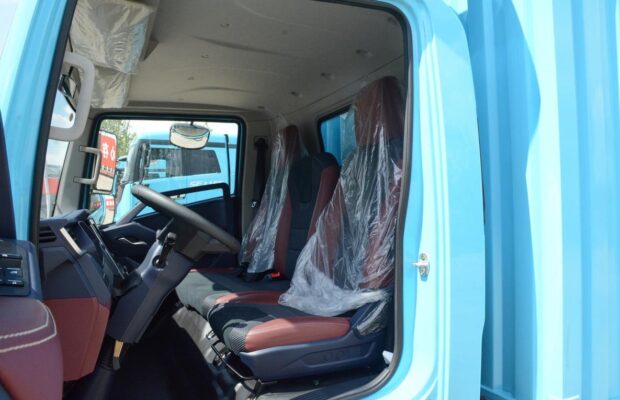Kamioi elektrikoaren berriak
Why Does the Battery Range Drop When the Air Conditioning is Turned On in New Energy Vehicles?
Posted on -z Kamioi elektrikoak
I believe many friends who have driven Ibilgailu Elektrikoas have experienced this. As soon as the air conditioning is turned on, especially when the heating is activated in winter, the battery range drops rapidly, almost as if the battery is leaking. Could there be an issue with the battery?
The answer is definitely no. Battery leakage would directly cause the vehicle to stop and is not related to the battery range. So, what is the actual reason behind this?

▎Why Does It Consume Electricity? Where Does the Electricity Go?
For our truck drivers who are accustomed to driving gasoline vehicles, particularly diesel ones, it seems that turning on the air conditioning slightly doesn’t have a significant impact, and there’s no obvious power attenuation. But when it comes to Ibilgailu Elektrikoasomattze, why does the air conditioning suddenly become one of the major power consumers? Some drivers are even extremely reluctant to turn on the air conditioning in winter, feeling helpless.
Power consumption! When discussing the power consumption of air conditioning, we must focus on the heating function of the air conditioning, which consumes relatively more electricity. First, let’s examine how Ibilgailu Elektrikoas achieve heating. Generally, most passenger vehicles utilize heat pump air conditioning and PTC resistance heating. Alabaina, due to various factors such as cost, heat pump air conditioning is not employed in trucks. Commonly, PTC resistance heating is utilized.
The heating principle of the PTC thermistor heating system is relatively straightforward. It’s similar to an electric stove wire. To put it more simply, it’s like an electric blanket. They all generate heat by passing current through the resistor. The only difference lies in the material of the resistor. Ordinary resistor wire is used in electric stoves, while semiconductor thermistor is used in pure Ibilgailu Elektrikoasomattze.
After the PTC resistance heating converts electricity into heat, the blower sends the hot air into the cab to achieve the heating effect. Usually, PTC heaters are widely adopted in pure Ibilgailu Elektrikoas due to their advantages like simple structure, low cost, and rapid heating.
If you still don’t comprehend, you can envision the electric hair dryer we use daily. Its principle and process are highly similar to the heating mechanism of Ibilgailu Elektrikoasomattze. I’m sure you’ll have a clear image in your mind.
Of course, compared to fuel vehicles where the waste heat of the engine is introduced into the passenger compartment for heating in winter, the drawbacks of PTC heating are evident. The higher the temperature setting and the longer the operating time, the greater the power consumption, which has a significant impact on the battery range of pure Ibilgailu Elektrikoasomattze.

After discussing heating, let’s explore how general vehicles cool down. When you activate the cold air conditioning, the power of the engine is transmitted to the air conditioning compressor via the belt, initiating its operation. At this point, the air conditioning compressor compresses the refrigerant and enables the refrigerant to flow. In different locations, the liquid refrigerant can transform into steam, and then the refrigerant in the steam state reverts to liquid. This process continuously absorbs heat to cool the air, and subsequently, the blower supplies cold air to the cab.
Just as mentioned earlier, the compressor is typically driven by the engine’s power. So, the question arises. Ibilgailu Elektrikoas do not have an engine. Is the drive motor used to provide kinetic energy to the compressor? This is clearly impossible. On one hand, the motor doesn’t operate when the vehicle is stationary, and at this time, there is no kinetic energy to drive the compressor to work. On the other hand, as can be observed from the actual images of electric vehicles, there are no additional devices near the drive motor of Ibilgailu Elektrikoasomattze, and they are often arranged separately.
So, where does the kinetic energy of the compressor originate? In fact, it is driven by the battery of the Ibilgailu Elektrikoa itself. Simply put, the air conditioning of an Ibilgailu Elektrikoa is essentially similar to the parking air conditioning. The electric air conditioning compressor has its own power source. Just supply it with electricity to drive the compressor to operate and provide continuous cooling for the vehicle.

▎Unreasonable Use of Air Conditioning Really Consumes a Lot of Electricity
I believe that after reading the above, drivers have discovered that both heating and cooling are driven by the battery of the Ibilgailu Elektrikoa itself. Consequently, when the air conditioning is turned on, it directly leads to an increase in power consumption and a reduction in the battery range.
Hortaz, in the future, when drivers activate the air conditioning, they need to be cautious. Do not set the air conditioning temperature to the extreme high or low. In fact, there’s no need to turn it to the highest gear. A suitable temperature suffices. This can reduce power consumption and maintain the temperature of the cockpit in a comfortable state.
Does opening the window for cooling instead of turning on the air conditioning in summer when driving at a speed of more than 80km/h definitely save more power? No. When the vehicle reaches a speed of more than 80km/h, a portion of the power is utilized to overcome wind resistance. At this moment, if you open the window for cooling, it will undoubtedly increase wind resistance further and result in higher power consumption. Thus, when the vehicle speed is relatively fast, it’s better to turn on the air conditioning.
In fact, although turning on the air conditioning increases power consumption, it is not the main power consumer. Frequent rapid acceleration or prolonged high-speed cruising is the main culprit for the shortening of the battery range. They cause the drive motor to remain in a high-load state for an extended period, leading to increased power consumption and a decrease in the battery range.
Hortaz, if drivers aim to save more power and extend the battery range, they should avoid rapid acceleration, aggressive driving, and prolonged high-speed cruising. Simultaneously, this is also beneficial for protecting the motor, preventing performance degradation and even demagnetization. After all, repairing the motor incurs significant costs.

● Editor’s Note
Bukatzeko, although turning on the air conditioning in an Ibilgailu Elektrikoa leads to a reduction in the battery range, by cultivating good habits, such as driving at a constant speed as much as possible, avoiding rapid acceleration and deceleration, using the air conditioning moderately, and rationally utilizing braking energy recovery, energy consumption can be effectively improved, which is beneficial for both daily vehicle usage and future maintenance.
Now, let’s explore some additional aspects and considerations related to the power consumption of Ibilgailu Elektrikoa air conditioning and overall energy efficiency:
The quality and insulation of the vehicle’s cabin can also have an impact on the power consumption of the air conditioning. A well-insulated cabin requires less energy to maintain the desired temperature, reducing the strain on the battery.
The type and efficiency of the battery itself can influence how much the air conditioning affects the range. Newer and more advanced battery technologies might be able to handle the additional load from the air conditioning more effectively.
Drivers should also be aware of the impact of external temperatures on air conditioning power consumption. In extremely hot or cold weather, the air conditioning system has to work harder to achieve the set temperature, resulting in higher energy usage.

The software and control systems of the Ibilgailu Elektrikoa can play a role in optimizing air conditioning usage. Some vehicles might have features that automatically adjust the air conditioning settings based on factors like battery charge level, driving conditions, and cabin temperature to balance comfort and energy conservation.
In addition to driving habits and air conditioning usage, the weight of the vehicle and the type of tires can also affect energy consumption. Heavier loads and less energy-efficient tires increase the power needed to move the vehicle, which in turn affects the battery range, especially when combined with air conditioning usage.
Finally, as technology continues to advance, researchers and manufacturers are constantly working on developing more energy-efficient air conditioning systems and improving overall vehicle energy management to minimize the impact of air conditioning on the battery range of Ibilgailu Elektrikoasomattze.
In the future, we can expect to see innovations such as more efficient heat pumps, better battery thermal management systems that integrate with the air conditioning, and smarter vehicle control algorithms that optimize both comfort and energy usage.
In the meantime, drivers can stay informed about the latest best practices and technological developments to make the most of their Ibilgailu Elektrikoa‘s range and performance, even when using the air conditioning.